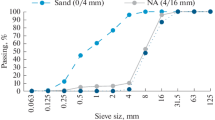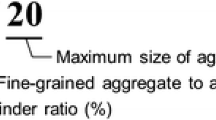Abstract
Coarse and fine aggregates generated from crushed concrete products for new concrete can be generally accepted only when the properties of recycled aggregate concrete, in addition to the relationships between different properties of such a concrete, are well understood. The results of an experimental investigation into the relationship of compressive strength to ultrasonic pulse velocity and to rebound number is presented in this paper. It has been observed that for the water-cured concrete the strength-pulse velocity relationship is influenced by the use of the recycled aggregate. For the same value of the pulse velocity, the strength of recycled aggregate concrete is higher than that for the natural aggregate concrete. On the other hand, the strength-rebound number relationship is not affected by the aggregate type used. The combined method of pulse velocity and rebound number for strength estimation is also evaluated.
Similar content being viewed by others
References
British Standards Institution, BS 6089 ‘Guide to the assessment of concrete strength in existing structures’ (BSI, London, 1981).
Bungey, J.H., ‘The testing of concrete in structures’ (Surrey University Press, London, 1982) p. 207.
Tam, C.T., ‘Non-destructive testing of concrete—limitation and usefulness’, 2nd Conference on Our World in Concrete and Structures, Singapore, August 1977, pp. 29–43.
Sri Ravindrarajah, R., and Tam, C.T., ‘Combined pulse velocity and rebound hammer method for evaluation of concrete strength’, Proc. of the Canadian Society of Civil Engineering Conference, Saskatoon, Canada, May 1985.
Sri Ravindrarajah, R., and Tam, C.T., ‘Properties of concrete made with crushed concrete as coarse aggregate’,Concrete Research,37 (130) (1985) 29–38.
Hansen, T.C., ‘Recycled aggregates and recycled aggregate concrete. Second state-of-the-art report—Developments 1978–1984’,Mater. Struct.,19 (1986) 201–246.
British Standards Institution, BS 12 ‘Specification for ordinary and rapid hardening Portland cement’ (BSI London, 1978).
British Standards Institution, BS 882, 1201—‘Specification for aggregates from natural sources for concrete (including granolithic) (BSI, London, 1973).
Buck, A.D., ‘Recycled concrete as a source of aggregate’, ACI Journal, Proc.74, 6, May 1977, pp. 212–219.
Malhotra, V.M., ‘Use of recycled concrete as a new aggregate’, in Proceedings of a symposium on Energy and Resource Conservation in the Cement and Concrete Industry, CANMET Report No. 76-8, Ottawa, 1978.
Rasheeduzzafar and Khan, A., ‘Recycled concrete—A source of new aggregate’,Cement, Concrete, and Aggregates,6 (1984) 17–27.
Tomsett, H.N., ‘The practical use of ultrasonic pulse velocity measurements in the assessment of concrete quality’,Concrete Research,32 (1980) 7–16.
Mayfield, B., and Whitham, R.P., ‘Assessment of-situ concrete strength’,Civil Engineering (UK) (1979) 41, 43–45.
Swamy, R.N., and Al-Hamed, A.H., ‘The use of pulse velocity measurements to estimate strength of concrete’, inIn-situ/Non-destructive testing of concrete, Ed. by V.M. Malhotra (ACI Special Publication, SP-82, 1984) pp. 247–276.
Samarin, A., and Meynink, P. ‘Use of combined ultrasonic and rebound hammer method for determining strength of concrete structural members’,Concrete International: Design & Construction,3 (1981) 25–29.
Galan, A., ‘Determination of the strength characteristics of concrete based on ultrasonic wave propagation combined with rebound hammer data’, Mater. Struct.,17 (1984) 201–206.
Knaze, P. and Beno, P., ‘The use of combined nondestructive testing methods to determine the compressive strength of concrete’, Mater. Struct.,17 (1984) 207–210.
Author information
Authors and Affiliations
Rights and permissions
About this article
Cite this article
Sri Ravindrajah, R., Loo, Y.H. & Tam, C.T. Strength evaluation of recycled-aggregate concrete byin-situ tests. Materials and Structures 21, 289–295 (1988). https://doi.org/10.1007/BF02481828
Issue Date:
DOI: https://doi.org/10.1007/BF02481828




